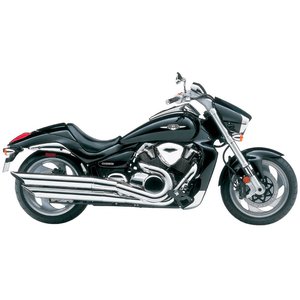Suzuki Boulevard M109R/Intruder M1800R (2006-2019): A Power Cruiser That Redefines Expectations
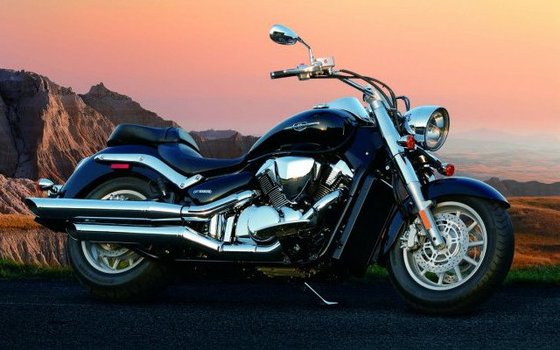
Introduction
When Suzuki set out to create a cruiser that could rival its sportbike siblings in sheer engineering audacity, the result was the Boulevard M109R (sold as the Intruder M1800R in some markets). From 2006 to 2019, this 1,783cc V-twin behemoth dominated the power cruiser segment with a blend of muscle-bound torque, race-derived technology, and head-turning aesthetics. Having thrown a leg over a well-maintained 2018 model, it’s clear why this motorcycle remains a cult favorite – it’s a machine that refuses to compromise between brutish acceleration and surprisingly nimble handling.
Design & Styling: A Fusion of Aggression and Elegance
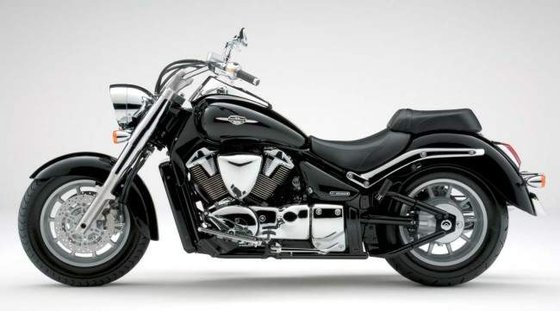
The M109R’s design is an exercise in controlled aggression. Its 54-degree V-twin engine isn’t just the centerpiece; it’s the star of the show, framed by a high-tensile steel double cradle frame. The signature elements – the trapezoidal headlight nacelle, the sculpted 19.5L fuel tank, and the 240mm rear tire (the widest ever fitted to a Suzuki) – give it a crouched, predatory stance.
- Key Design Features:
- 2-into-1-into-2 Exhaust: A burly, chrome-accented system that amplifies the engine’s GSX-R-inspired growl.
- Radial Brakes: Tokico 4-piston calipers gripping 310mm discs (borrowed from the GSX-R1000) scream sportbike DNA.
- Low Seat Height: At 705mm (27.8"), it’s accessible for shorter riders despite its 347kg (765 lbs) wet weight.
The M109R’s ergonomics strike a balance between cruiser relaxation and sporty intent. The pullback bars and mid-mounted footpegs let you stretch out, while the slightly rear-set pegs on later models add a hint of aggression.
Engine & Performance: Where Cruiser Meets Superbike

Suzuki’s 1,783cc liquid-cooled V-twin isn’t just big – it’s clever. With 123–125 HP @ 6,200 RPM and a stump-pulling 160 Nm (118 lb-ft) of torque @ 3,200 RPM, this engine is a masterclass in low-end grunt. Key innovations include:
- Forged Pistons: At 112mm in diameter, these are among the largest production motorcycle pistons ever made. Paired with SCEM (Suzuki Composite Electrochemical Material)-plated cylinders, they ensure minimal friction and heat dispersion.
- Dual Throttle Valve (SDTV) Fuel Injection: Delivers crisp throttle response, eliminating the sluggishness typical of big cruisers.
- Suzuki Advanced Sump System (SASS): A semi-dry sump design lowers the engine’s center of gravity, aiding handling.
On the Road: Crack the throttle, and the M109R surges forward with a ferocity that belies its cruiser label. The torque curve feels like a flat line from 2,500 RPM onward, making highway overtakes or uphill pulls effortless. The 5-speed transmission (with shaft drive) is slick, though a 6th gear would’ve been welcome for long hauls.
Handling & Ride: Surprisingly Agile for a 765-Pound Beast
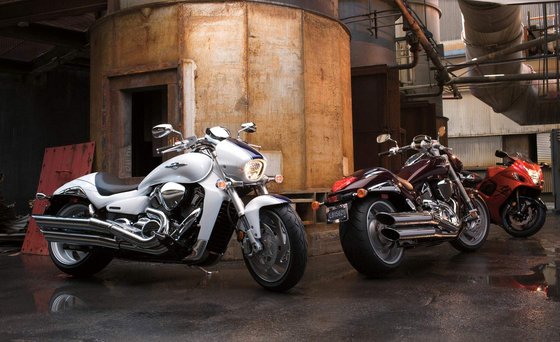
Don’t let the cruiser tag fool you – the M109R handles like a sportbike that’s been fed too many protein shakes.
- Chassis: The double-cradle steel frame and cast aluminum swingarm provide rigidity, while the 46mm inverted KYB forks (130mm travel) and link-type rear suspension (120mm travel) soak up bumps without wallowing.
- Tires: The 130/70-R18 front and 240/40-R18 rear Dunlop provide staggering grip, though the rear’s width demands deliberate countersteering in tight corners.
- Brakes: Radial-mounted Tokico 4-piston calipers offer bite and feedback that shame most cruisers.
Riding Impressions: At low speeds, the M109R feels its weight, but once rolling, it transforms. The steering is neutral, and the chassis encourages lean angles that’ll drag pegs sooner than expected. The shaft drive adds minimal driveline lash, a testament to Suzuki’s engineering.
Competition: How the M109R Stacks Up
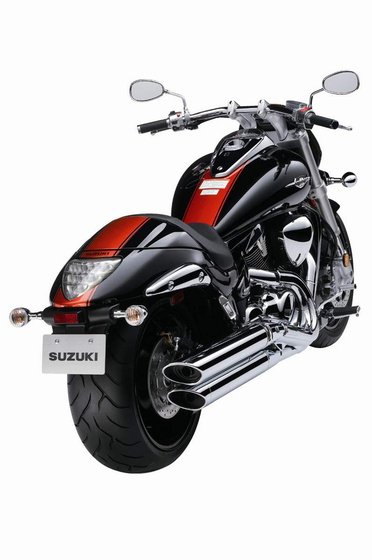
In the power cruiser arena, the M109R faced fierce rivals but carved its niche with a unique blend of tech and raw power:
- Harley-Davidson V-Rod (2001–2017):
- Pros: Porsche-designed 1,250cc Revolution engine, lighter at 304kg (670 lbs).
- Cons: Less torque (115 Nm), higher seat (711mm), and a dated final belt drive.
-
Verdict: The V-Rod is a boulevardier; the M109R is a corner-carver.
-
Yamaha VMAX (2009–2020):
- Pros: 1,679cc V4 with 200 HP, rocket-ship acceleration.
- Cons: Heavier (383kg/845 lbs), worse fuel range, stratospheric price.
-
Verdict: The VMAX is a dragstrip weapon; the M109R is the everyday muscle.
-
Honda VTX1800 (2001–2010):
- Pros: Butter-smooth 1,795cc V-twin, iconic styling.
- Cons: Archaic suspension, vague steering, no fuel injection until 2006.
- Verdict: The VTX is a relaxed cruiser; the M109R is for thrill-seekers.
Maintenance: Keeping the Beast Roaring
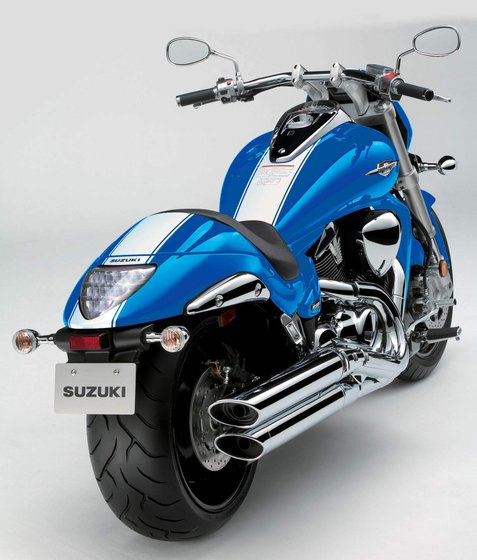
The M109R is relatively low-maintenance for its class, but attention to these areas ensures longevity:
- Shaft Drive:
- Every 24,000 km (15,000 mi): Replace final drive oil (SAE 80W-90).
-
Check: Inspect seals for leaks during tire changes.
-
Valve Adjustments:
-
Every 24,000 km (15,000 mi): Shim-under-bucket design requires patience but ensures long intervals.
-
Cooling System:
- Every 2 years: Replace coolant (Suzuki Long-Life Coolant recommended).
-
Watch For: Early models (2006–2008) had occasional thermostat housing leaks.
-
Tires:
-
The 240mm rear tire (Dunlop D407) wears quickly under hard riding – expect 8,000–12,000 km (5,000–7,500 mi). Consider Metzeler Cruisetec for longer life.
-
Upgradable Parts:
- Brake Pads: Swap stock Tokico pads for EBC HH sintered pads for better bite.
- Air Filter: K&N SU-7610 improves airflow and is reusable.
Pro Tip: The ECU can be remapped to address the stock lean fueling in lower RPMs – a common gripe in emissions-strangled models post-2010.
Conclusion: A Modern Classic That Demands Respect
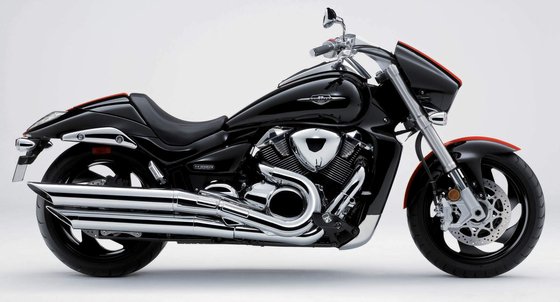
The Suzuki Boulevard M109R/Intruder M1800R isn’t just a cruiser – it’s a statement. It’s for riders who want the visceral punch of a superbike but refuse to sacrifice comfort or style. While its weight and thirst for premium fuel (expect 6.6 L/100km or 36.6 MPG) aren’t for everyone, few machines in its class deliver such a thrilling paradox of raw power and refined engineering.
Whether you’re carving canyon roads or turning heads on Main Street, the M109R remains a testament to Suzuki’s golden era of innovation. And with a vast catalog of aftermarket parts – from performance exhausts to ergonomic upgrades – it’s a platform that rewards those willing to make it their own.
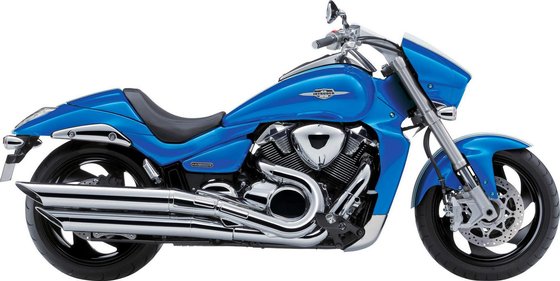





Specifications sheet
| Engine | |
|---|---|
| Stroke: | Four-stroke |
| Max power: | 92 kW | 123.0 hp |
| Max torque: | 160 Nm |
| Fuel system: | Fuel Injection (Suzuki Dual Throttle Valve SDTV with 56mm throttle bodies) |
| Max power @: | 6200 rpm |
| Displacement: | 1783 ccm |
| Max torque @: | 3200 rpm |
| Bore x stroke: | 112.0 x 90.5 mm (4.4 x 3.6 in) |
| Configuration: | V |
| Cooling system: | Liquid |
| Compression ratio: | 10.5:1 |
| Lubrication system: | Semi-dry sump (SASS) |
| Number of cylinders: | 2 |
| Valves per cylinder: | 4 |
| Dimensions | |
|---|---|
| Wheelbase: | 1710 mm (67.3 in) |
| Dry weight: | 319 |
| Wet weight: | 347 |
| Seat height: | 705 mm (27.8 in) |
| Overall width: | 875 mm (34.4 in) |
| Overall height: | 1130 mm (44.5 in) |
| Overall length: | 2450 mm (96.5 in) |
| Ground clearance: | 130 mm (5.1 in) |
| Fuel tank capacity: | 19.5 L (5.15 US gal) |
| Drivetrain | |
|---|---|
| Final drive: | Shaft |
| Gear ratios: | ['1st 2.188', '2nd 1.400', '3rd 1.038', '4th 0.828', '5th 0.686'] |
| Transmission: | 5-speed constant mesh |
| Primary reduction ratio: | 1.647 |
| Maintenance | |
|---|---|
| Rear tire: | 240/40-18 |
| Engine oil: | 10W40 |
| Front tire: | 130/70-18 |
| Brake fluid: | DOT 4 |
| Spark plugs: | NGK CR8E or CR8EIX |
| Spark plug gap: | 0.8 |
| Engine oil capacity: | 4.7 |
| Engine oil change interval: | Every 5000km or 2 years |
| Valve clearance (intake, cold): | 0.10–0.20 mm |
| Valve clearance check interval: | 24,000 km / 15,000 mi |
| Valve clearance (exhaust, cold): | 0.20–0.30 mm |
| Recommended tire pressure (rear): | 2.5 bar (36 psi) solo / 2.8 bar (41 psi) with passenger |
| Recommended tire pressure (front): | 2.25 bar (33 psi) |
| Additional Features | |
|---|---|
| Warranty: | 12-month unlimited mileage limited warranty |
| Exhaust system: | 2-into-1-into-2 stainless steel chromed with Suzuki Exhaust Tuning (SET) |
| Instrumentation: | Analog speedometer, LCD odometer, digital tachometer, fuel gauge, clock |
| Special variants: | Limited Edition models available with unique colors/trim |
| Chassis and Suspension | |
|---|---|
| Frame: | High-tensile double cradle steel |
| Rear wheel: | 8.50 x 18 in |
| Front wheel: | 3.50 x 18 in |
| Rear brakes: | Single 274mm disc with 2-piston caliper (ABS on some models) |
| Front brakes: | Dual 310mm discs with radial-mount 4-piston Tokico calipers (ABS on some models) |
| Rear suspension: | Link-type monoshock with adjustable preload, 120mm (4.7 in) travel |
| Front suspension: | Inverted telescopic forks, 46mm stanchions, 130mm (5.1 in) travel |



